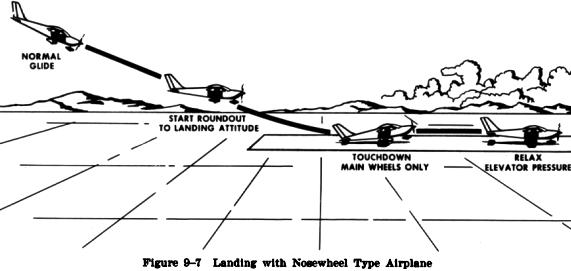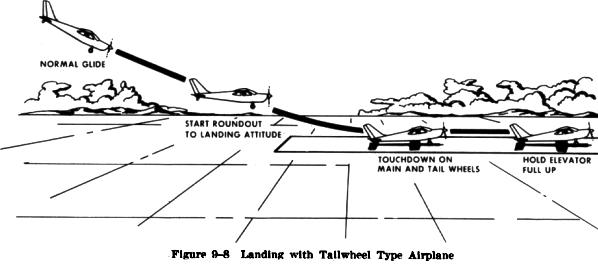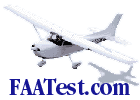| Touchdown
The touchdown is the gentle settling of the airplane onto the landing surface. The roundout and touchdown should be made with the engine idling, and the airplane at minimum controllable airspeed, so that the airplane will touchdown on the main gear at approximately stalling speed. As the airplane settles, the proper landing attitude must be attained by application of whatever back elevator pressure is necessary. Some pilots may try to force or fly the airplane onto the ground without establishing the proper landing attitude. It is paradoxical that the way to make an ideal landing is to try to hold the airplane's wheels a few inches off the ground as long as possible with the elevators. In most cases, when the wheels are within about two or three feet off the ground, the airplane will still be settling too fast for a gentle touchdown; therefore, this descent must be retarded by further back pressure on the elevators. Since the airplane is already close to its stalling speed and is settling, this added back pressure will only slow up the settling instead of stopping it. At the same time, though, it will result in the airplane touching the ground in the proper landing attitude. 
Nosewheel type airplanes should contact the ground in a tail low attitude, with the main wheels touching down first so that little or no weight is on the nosewheel (Fig. 9-7). In tailwheel type airplanes, the roundout and touchdown should be so timed that the wheels of the main landing gear and tailwheel touch down simultaneously (3 point landing). This requires fine timing, technique, and judgment of distance and altitude (Fig. 9-8). 
In nosewheel type airplanes, after the main wheels make initial contact with the ground, back pressure on the elevator control should be held to maintain a positive angle of attack for aerodynamic braking and to hold the nosewheel off the ground until the airplane decelerates. As the airplane's momentum decreases, back pressure may be gradually relaxed to allow the nosewheel to gently settle onto the runway. This will permit prompt steering with the nosewheel, if it is of the steerable type. At the same time it will cause a low angle of attack and negative lift on the wings to prevent floating or skipping, and will allow the full weight of the airplane to rest on the wheels for better braking action. The airplane should never be "flown on" the runway with excess speed. When the wheels of tailwheel type airplanes make contact with the ground, the elevator control should be carefully eased fully back to hold the tail down and the tailwheel on the ground. This provides more positive directional control of the airplane equipped with a steerable tailwheel, and prevents any tendency for the airplane to nose over. If the tailwheel is not on the ground, easing back on the elevator control may cause the airplane to become airborne again because the change in attitude will increase the angle of attack and produce enough lift for the airplane to fly. It is extremely important that in either type of airplane, the touchdown occur with the airplane's longitudinal axis exactly parallel to the direction in which the airplane is moving along the runway. Failure to accomplish this not only imposes severe sideloads on the landing gear, but imparts groundlooping (swerving) tendencies, particularly to tailwheel type airplanes. To avoid these side stresses or a groundloop, then, the pilot must never allow the airplane to touch down while in a crab or while drifting.
|
